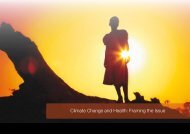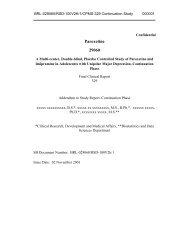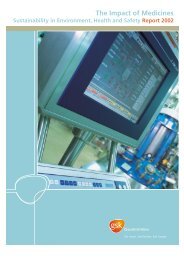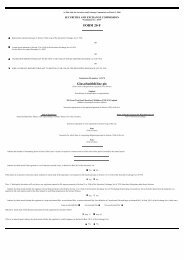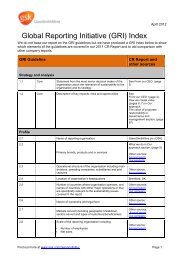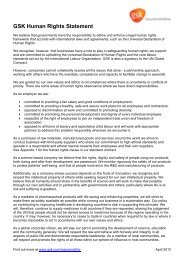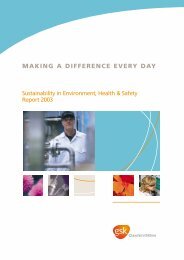GSK Annual Report 2002
GSK Annual Report 2002
GSK Annual Report 2002
You also want an ePaper? Increase the reach of your titles
YUMPU automatically turns print PDFs into web optimized ePapers that Google loves.
54 GlaxoSmithKline Operating and financial review and prospects<br />
US sales growth benefited in the quarter from increases in<br />
wholesaler stocks on some products to more normal operating<br />
levels, and a year end review of customer discount and rebate<br />
provisions. As a result, underlying growth for the quarter excluding<br />
these items was estimated by management to be in the high single<br />
digit range, in spite of generic competition for Augmentin.<br />
Pharmaceutical sales by therapeutic area<br />
Across the Group’s portfolio of products, six major therapeutic areas<br />
experienced double-digit percentage growth for the year, including<br />
the fast growing franchises: CNS (£4.5 billion) up 17 per cent;<br />
respiratory (£4.0 billion) up 16 per cent; anti-virals (£2.3 billion) up<br />
12 per cent, and vaccines (£1.1 billion) up 16 per cent.<br />
Central nervous system<br />
Sales of Seroxat/Paxil, GlaxoSmithKline’s leading product for<br />
depression and anxiety disorders, was the driver of growth in the<br />
CNS therapy area, with sales of £2 billion, up 15 per cent globally<br />
and 18 per cent in the USA. International sales of Paxil grew<br />
27 per cent to £267 million led by continued strong growth in<br />
Japan, where the product was launched only two years ago.<br />
Launched in April <strong>2002</strong>, Paxil CR continues to gain acceptance<br />
due to its strong tolerability profile, and it now represents over<br />
30 per cent of all new US prescriptions for Paxil in just 10 months.<br />
Sales of Wellbutrin, for depression, grew 42 per cent to<br />
£882 million, reflecting increased physician awareness of the<br />
product’s outstanding efficacy and favourable side effect profile.<br />
In <strong>2002</strong>, an application for approval of a once-daily formulation,<br />
Wellbutrin XL, was submitted to the FDA.<br />
GlaxoSmithKline’s medicine for epilepsy, Lamictal, continued to<br />
grow across all regions achieving sales of £438 million, up<br />
27 per cent. In <strong>2002</strong>, the Group filed an sNDA for Lamictal seeking<br />
the first-ever indication for long-term management of depressive<br />
episodes in bipolar disorder. In January 2003, the FDA approved<br />
the use of Lamictal for the treatment of partial seizures in<br />
paediatric patients aged two years and above.<br />
Respiratory<br />
GlaxoSmithKline continues to be the global leader in respiratory<br />
pharmaceuticals with sales of its three key products -<br />
Seretide/Advair, Flixotide/Flovent and Serevent - amounting to<br />
nearly £3 billion, up 25 per cent.<br />
Sales of Seretide/Advair, GlaxoSmithKline’s second largest product,<br />
grew 96 per cent to £1.6 billion although this contributed to<br />
declines in Serevent and Flixotide, its constituent products. Advair<br />
is now the US asthma market leader in new prescriptions after less<br />
than two years on the market. Seretide also continued to perform<br />
strongly in Europe (up 36 per cent) and International markets<br />
(up 92 per cent). In January 2003, GlaxoSmithKline received a<br />
positive opinion from the European Committee for Proprietary<br />
Medicinal Products (CPMP) for the use of Seretide as a new<br />
treatment for Chronic Obstructive Pulmonary Disease (COPD). The<br />
Group expects European marketing authorisation within the next<br />
few months followed by launches across Europe during the first<br />
half of 2003. In December <strong>2002</strong>, GlaxoSmithKline filed an NDA for<br />
Ariflo for COPD.<br />
The older respiratory products Ventolin and Becotide continued to<br />
decline as patients converted to newer products.<br />
Anti-virals<br />
HIV medicines grew across all regions and totalled £1.5 billion in<br />
sales, up 13 per cent. Sales of Trizivir, GlaxoSmithKline’s new triple<br />
combination therapy, grew 95 per cent to £315 million.<br />
Valtrex, for herpes, continued to benefit from its convenient<br />
once-daily dosing for suppressive therapy and achieved strong<br />
sales growth of 26 per cent worldwide and 35 per cent in the<br />
USA. In October <strong>2002</strong>, GlaxoSmithKline filed an sNDA for Valtrex<br />
seeking the first-ever indication to reduce the risk of transmission<br />
of genital herpes. In December <strong>2002</strong>, GlaxoSmithKline filed an<br />
NDA for ‘908’, a protease inhibitor, for the treatment of HIV. The<br />
decline in Zovirax sales reflected transfers to the newer Valtrex<br />
and generic competition.<br />
Anti-bacterials<br />
Anti-bacterial sales declined 12 per cent worldwide and 22 per cent<br />
in the USA. Augmentin’s US sales were down 20 per cent in the<br />
year as a result of generic competition that began in the third<br />
quarter. Four generic versions of Augmentin have been introduced<br />
in the USA following a decision by the US District Court for<br />
Eastern Virginia that held invalid GlaxoSmithKline’s patents on<br />
Augmentin expiring in <strong>2002</strong>, 2017 and 2018. A hearing on<br />
GlaxoSmithKline’s appeal of the court’s decisions has been<br />
scheduled for 5th March 2003. US sales of Ceftin declined<br />
80 per cent, due to generic competition which began during<br />
the first quarter, <strong>2002</strong>.<br />
In the USA, GlaxoSmithKline’s two new antibiotics, Augmentin ES<br />
for children, and Augmentin XR for adults, are performing well.<br />
The ES formulation, launched in the fourth quarter of 2001, now<br />
represents 49 per cent of all branded and generic Augmentin<br />
paediatric prescriptions. Based on recent weekly data, the XR<br />
formulation, launched in October, now represents 14 per cent of<br />
all branded and generic Augmentin adult prescriptions.<br />
Metabolic and gastro-intestinal<br />
Worldwide sales for the metabolic and gastro-intestinal category<br />
were £1.4 billion, up one per cent. The Avandia franchise<br />
(Avandia and Avandamet) grew 19 per cent for the year with US<br />
sales up 15 per cent to £688 million.<br />
Avandamet, a combination of Avandia and metformin HCI,<br />
expanded the Avandia metabolic franchise with its US launch in<br />
the fourth quarter. Avandamet for the treatment of type 2<br />
diabetes is the first medicine that targets insulin resistance and<br />
decreases glucose production in one convenient pill. Since its<br />
approval by the FDA in May 1999, Avandia has been used by over<br />
four million patients worldwide.<br />
Zantac sales were £382 million (down 21 per cent) with declines<br />
in most markets.<br />
Vaccines<br />
Sales of vaccines grew 16 per cent to over £1 billion, supported<br />
by the Hepatitis franchise, up 12 per cent to £483 million, with<br />
total sales in Europe growing 17 per cent. US sales grew<br />
16 per cent from the launch of Twinrix and continued growth in<br />
Havrix, driven by new state mandates requiring Hepatitis A<br />
vaccination of school age children. Infanrix (GlaxoSmithKline’s<br />
DTPa range of combination vaccines) grew eight per cent to<br />
£254 million. Priorix and Tritanrix grew 29 per cent and 54 per cent<br />
respectively. In the USA, GlaxoSmithKline’s new Pediarix vaccine<br />
was launched in January 2003. Pediarix adds protection against<br />
hepatitis B and poliomyelitis to the Infanrix combination, and<br />
results in up to six fewer injections for infants.






